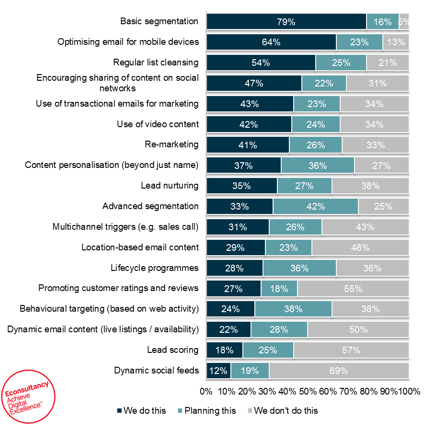How Machine Learning Takes Email Marketing to New Heights
The possibilities and potential for machine learning never fail to amaze me, whether they could make my personal life easier (now my kitchen appliances can talk to each other, but do I want to know what they're saying about me?) or open up new vistas for email marketers.
In case you're wondering whether machine learning (alternatively called "cognitive computing," "deep simulation" or "artificial intelligence") is real or just the latest distracting shiny toy, no less an expert than Steven Sinofsky, an investor and startup adviser among other credits, assures us that it's not.
"Over the course of the past year, AI has gone from passing reference through implementation to daily use," he writes in his wrap-up of the latest Code Conference earlier this month. "Today's use of AI is not hype but reality."
Here's just a smattering of what's on the horizon or already in living rooms:
- The Amazon Echo, a device built on its Alexa platform and uses voice commands, agents and machine learning to automate all kinds of household needs and tasks, now called "endpoints."
- Using machine learning to manage maintenance and navigation in Ford cars.
- Creating a more personalized and curated shopping experience and eliminating fraud on eBay.
- The Olli driverless mini-bus powered by IBM's Watson.
- Innit, a system that connects your kitchen appliances (fridge, stove, microwave, etc.) and uses data, machine learning and sensors to learn more about the food you’re cooking and reduce spoilage or cooking errors.
All of these are game-changers, but machine learning is already working to help email marketers do their jobs and serve their customers better.
The holy grail: Timely, relevant and personalized email messages
A quick refresher: Machine learning, at its simplest, is a method of data analysis that allows computers to learn – to analyze, predict and act – without explicit instructions or programming.
We've used data this way for years – think of triggered emails – but we've always had to write the rules. Machine learning doesn’t wait for you to write a rule. Instead, its algorithms act on and learn from data to take the next steps on its own.
Machine learning makes sense of all the data that floods in through every customer touch point: before the first contact, during the whole prospecting process, the first sales, on through either loyalty or abandonment.
Benefits for all: As I wrote in my earlier Only Influencers article ("Using Machine Learning in Email for 'Always On' Optimization"), machine learning combines 1:1 personalization and scale, to create timely, relevant messages for every person in your database.
Being able to glean greater insight and meaning from data and use it automatically drives better messaging for customers. For example, it takes the work out of subject line and copy testing and optimization.
Your subscribers will be able to find answers and solutions more efficiently than in undifferentiated email copy that doesn’t indicate anywhere that your company knows anything at all about them.
If you can serve customers better, they'll stay longer, buy more and buy more often. That leads to higher customer lifetime value. It's the best value exchange I can think of, a total win-win.
What's holding us back?
Marketing has evolved by leaps and bounds even in the last five to seven years but we're not taking advantage of all the innovations available to us. This chart, from Econsultancy's "Email Marketing Industry Census 2016" shows how many marketers say these practices are part of their email marketing efforts:

So, if marketers have barely progressed beyond basic segmentation and mobile optimization, why should they take the leap to machine learning? Because email-focused developers have done all the hard work and are making the technology available and easier to use for a wider range of companies.
Machine learning in action
Alchemy Worx offers email marketing’s first newsletter automation service. Instead of creating fresh content for a weekly broadcast email campaign – a tedious and time-consuming process – you spend time developing a dynamic content library.
Your newsletter system filters this through a goals-driven structure to produce highly personalised content.
You get enhanced customer insights, which in turn enables better results and delivers more intelligent marketing, with the results continually improving as more data (via actions) is provided by the users.
Jetlore: This content company builds user profiles using semantic attributes instead of specific products and natural language processing instead of database tags. It re-ranks content according to user interactions in real time and makes real-time changes in content before the subscriber opens the email based on website behavior.
Machine learning tracks the content displayed to ensure an adaptive, personalized, consistent and non-repetitive experience for each subscriber.
Wylei: Personalization is a hypothesis until you test it. Machine learning applies these tests automatically and continually. Instead of testing, getting a result and moving on, your material is constantly being refined and improved as more data comes in.
You can see that principle at work on their cloud-based relevance engine and Adaptive Content portal which they use to test and recognize patterns in email behavior and to test and continually adapt email content dynamically for best results after identifying what works best for different categories of users.
What's next?
In his Recode article, Steven Sinovsky credits "an incredibly rapid and deep technology diffusion" as the reason why machine learning has moved so swiftly from the stuff of dreams and science fiction to real-world applications.
We can see this happening right now with the three examples of machine learning adapted for email marketing that I cited above. I believe it's critical that we all learn more and look for ways to incorporate it into our email programs or risk being left behind.

 How to resolve AdBlock issue?
How to resolve AdBlock issue? 